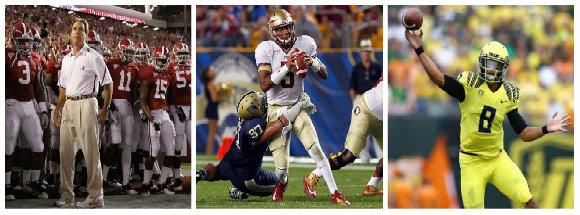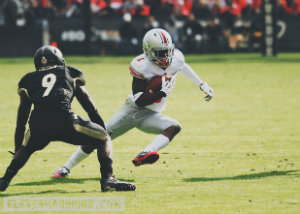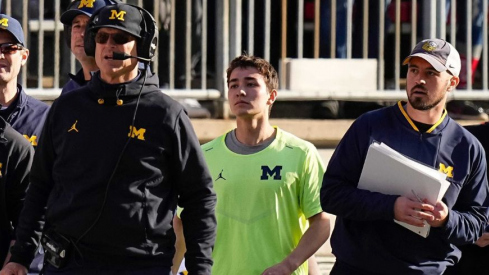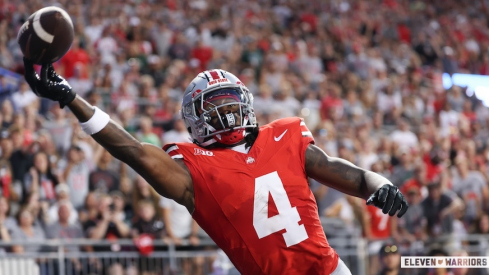
The Buckeyes might not have a game this week, but it's nevertheless one of the most important weeks of the season for Urban Meyer's squad. Beginning with two Thursday night games, it will be a decisive week for the other potential national championship challengers.
First up is Oklahoma-Baylor, followed later tomorrow night by the pivotal Oregon-Stanford matchup. On Saturday, Florida State only has Wake Forest (but maybe that's ok), but then Alabama squares off against LSU in the College Gameday game of the week.
So continuing our unofficial bye-week focus on the other BCS challengers – check out the strength of schedule/media analysis, why the Buckeyes will make the title game, and BCS ranking analysis – below I take a look behind the numbers for Florida State, Baylor, Oregon, and Alabama in comparison with the Buckeyes.
As a frame of reference, here are some statistics for the Buckeyes:
| Off PPP | Def PPP | Off YPP | Def YPP | Turnover | Ex Plays | Red Zone TD |
|---|---|---|---|---|---|---|
| .64 | .26 | 7.0 | 4.8 | +9 | 53:20 | 83% |
These aren't the end-all-be-all of football statistics, but this collection of metrics certainly gives a nice quick picture of a team for which to build on. YPP here stands for yards per play instead of yards per point. For the explosive plays column, I compared the number of offensive plays of 20+ yards against the number of 20+ yard plays allowed by the defense.
Alabama
| Off PPP | Def PPP | Off YPP | Def YPP | Turnover | Ex Plays | Red Zone TD |
|---|---|---|---|---|---|---|
| .64 | .17 | 7.2 | 1.8 | +5 | 49:27 | 69% |
Alabama is extremely similar to Ohio State across the major metrics (especially in their identical points per play), except for a few key differences.
First, Alabama's defensive yards per play is significantly lower than Ohio State's, despite fairly similar defensive points per play numbers. Complicating the picture is that Ohio State's defense has held opponents to fewer explosive plays. So, the Buckeye defense has been better at limiting big plays but gives up more yards per play, even though opponent drive efficiency is similar for both squads.
While both teams have positive turnover margins, Ohio State has been the beneficiary of more turnovers (Alabama has eight interceptions to OSU's eleven).
Finally, the Buckeyes have a significantly better red zone touchdown conversion percentage than Alabama.
In the event of an Ohio State-Alabama matchup and just looking at the numbers, I'd imagine that the Buckeye would play aggressively in pass coverage while attempting to exploit the Alabama corners for big gains in the passing game.
Oregon
| Off PPP | Def PPP | Off YPP | Def YPP | Turnover | Ex Plays | Red Zone TD |
|---|---|---|---|---|---|---|
| .71 | .21 | 8.1 | 4.4 | +13 | 71:19 | 71% |
 Dontre would be a tough matchup for any defense
Dontre would be a tough matchup for any defense At this point in the season, Oregon has superior numbers for every single metric above except for red zone touchdown percentage.
I have two thoughts here. First, while better than the Buckeyes statistically, the Buckeyes are in the ballpark – and absolutely competitive – in every stat. The only number that Oregon has a wide margin over the Buckeyes is in offensive explosive plays, where Oregon has 18 more than the Buckeyes.
Many are looking to the 2010 Rose Bowl for evidence that the Buckeyes could handle the Ducks this season, but I think that comparison isn't all that worthwhile. That team had an almost entirely different coaching staff, a different offensive system (i.e. the current offense actually has a system), and a different starting quarterback. Conversely, the Ducks were led by Jeremiah Masoli instead of Heisman-caliber Marcus Mariota.
Instead, I think the 2013 Buckeyes could win over the Ducks because we simply don't know enough about Oregon yet. Their only potential challenge could have come from UCLA, and their win over Nebraska looks less impressive each week. We'll learn much more about Mariota and company later when they meet Stanford.
Florida State
| Off PPP | Def PPP | Off YPP | Def YPP | Turnover | Ex Plays | Red Zone TD |
|---|---|---|---|---|---|---|
| .75 | .20 | 8.1 | 4.3 | +8 | 66:20 | 76% |
Like Oregon, FSU has many superior numbers compared to the Buckeyes, except for turnover margin, redzone touchdown percentage, and opponent explosive plays. Again, like Oregon, the Buckeyes are comparable in every metric.
Florida State's most impressive metric is their offensive points per play, which is near the top in the country behind Baylor. Winston is capable of leading sustained drives that end in touchdowns, without just relying on big plays (though they've produced plenty of those as well).
Baylor
| Off PPP | Def PPP | Off YPP | Def YPP | Turnover | Ex Plays | Red Zone TD |
|---|---|---|---|---|---|---|
| .80 | .21 | 9.0 | 4.2 | +5 | 69:25 | 72% |
Baylor is an interesting case because their numbers are absolutely through the roof (only two teams have kept them under 70 points per game). Further, I'm not sure that Oklahoma is really the best test for Baylor offensively or defensively.
What is certain is that Baylor's passing game would be a stiff challenge for the Buckeye secondary. A matchup with Baylor looks to be a shootout on paper, though I think their defensive statistics are mainly the result of their schedule, rather than any overwhelming talent. I would imagine that Herman would dial up a run-heavy game plan that would strive for high drive efficiency and ball control, while trying to keep everything in front of them on defense. The Kansas State defensive gameplan is illustrative here.
Conclusions
Ohio State's four challengers all have several characteristics in common: extremely high explosive play ratios, high turnover margins, high points per play numbers, and get touchdowns out of red zone visits at least 2/3 of the time.
So where does Ohio State have an edge? The Buckeyes are third in the country and tops among the five here in red zone touchdown conversion percentage, continuing Urban and Herman's trend from 2012. They also lead the country in rushing plays of more than ten yards, a testament both to Carlos Hyde and the offensive line. Further, their rush defense is the best of the challengers, with opponents averaging just 2.8 yards per carry.
I'd also caution that these numbers don't control for specific matchups, strategy, or strength of schedule. For instance, while Alabama has the edge over the Buckeyes in both offensive and defensive points per play and yards per play metrics, they were eviscerated by the Texas A&M offense.
Meyer and Herman have shown that they have the ability to gameplan extremely well, and this isn't as easily captured by season-level statistics.

